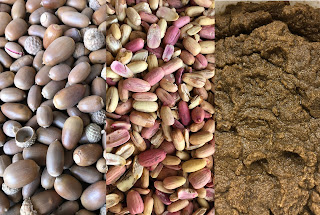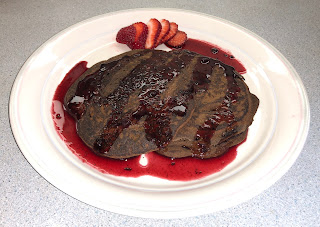 |
Quecus Gambelii
|
There are many species of
Oak, but in my area there is only one common species in the wild,
Quercus gambelii, or
Gambel Oak. This is a fairly adaptable species, and can grow into a tall tree in the right conditions, but mainly it adapts to the desert by becoming what it is more commonly known as:
scrub oak. It is usually found on dry mountain slopes, where it forms dense thickets of scrub. There are no thorns on oak, but the tough wood and tortuous shaped branches make these thickets some of the worst terrain for off-trail bushwhacking.
The one advantage to getting your acorns from low growing scrub oak is that you don't have to wait for the acorns to fall to the ground on their own. You can pick them directly from the branches. Of course you should wait until they are ripe enough that some have begun to fall. I picked some off the ground, and some from the tree. Then I left them outside for a few weeks, so the green ones from the tree had time to fully ripen. They completed turning brown, and were the same inside as the ones from the ground. I think there were fewer bug-eaten acorns in the ones I picked directly from the tree, but that could also have been due to picking from a different location.
 |
acorns before shelling,
acorns after shelling,
wet acorn meal after leaching. |
Acorns are a labor-intensive food, and there are many guides on various ways to crack, shell, leach, and grind them to get acorn flour. Some people report cracking to be difficult, because the shells are tough, but because mine had set outside for a while, my shells were dry and brittle and cracked easily. I used a rock to crack them, either on a concrete surface or on a flat but slightly concave rock I found near a stream. The shelling was the most fiddly and time consuming part. Acorns came out in one of three ways. Most were white or pinkish because they were fresh. Some were dark brown and shrunken because they had had time to dry out while they were in the outside air. They dry ones fall out of the shell easily, and some people deliberately dry their acorns to make shelling easier. (I kept my dried acorns separate during the processing, and I did not notice any difference in taste in the end product.) The third category is a brown powder, which is what is left after the dreaded oak weevil grub has finished eating the acorn. Throw these ones away. There are always some of these, but if you see a small hole in the acorn, that is were the grub escaped from, and you can toss the acorn without bothering to crack it.
Next comes the leaching step. All acorns have tannins, and in fact every part of the oak tree is high in tannins. While small amounts are not harmful, they taste quite bitter, and large amounts are used for tanning leather, which you probably do not want to happen to your stomach. The traditional way to leach out the tannins is to hang them in a bag in a stream for a day or so, but by the time I got to this step, my streams were about half iced over. There are many other ways: hot and cold, slow and fast. I chose a cold, fast method. This requires the acorns to be ground up first. I used a blender and blended them about 2 cups at a time with some water to make an acorn slurry. This is placed in a filter bag and fresh water is run through it for 10-15 minutes. The acorns are the most bitter after grinding, and you should sample them after leaching to be sure all the bitterness is gone. My last batch needed extra time, probably because the bottom of the bowl had more of the nut skins, which are reported to be extra bitter. (If this seems like a wasteful use of water, try not to think about how much water we use to irrigate our lawns here.)
 |
Acorn Bread!
|
My product after grinding and leaching was a wet ball of acorn flour, with about the same consistency as corn meal. So it seemed obvious to use a cornbread recipe to make acorn bread, but substituting acorn meal for corn meal. This turned out very good, and everyone liked it, especially with butter or honey or better yet, honey-butter. It was nutty and sweetish, and somewhat comparable to bran muffins in flavor.
 |
Acorn pancakes
with elderberry-hawthorn syrup |
To completely finish the process, the acorn meal which I did not use right away was dried and ground again into a finer flour. Because acorns are high in fat content, this is best stored in a freezer. Then I used this fine acorn flour to make acorn pancakes (using acorn flour, eggs, water, and baking soda). Since the acorn flour has less binding starches than wheat flour, the pancake can be a bit fragile, so it helps to wait a little longer before flipping. It seems best to wait until the uncooked side has set up a bit and lost the appearance of batter. But it still splats nicely on the flip and gets a good second surface, which wheat pancakes often do not do if you wait that long. My acorn pancakes had a pleasant nutty flavor, and tasted especially good with the elderberry-hawthorn syrup I made this year. This is a rare gourmet experience.



